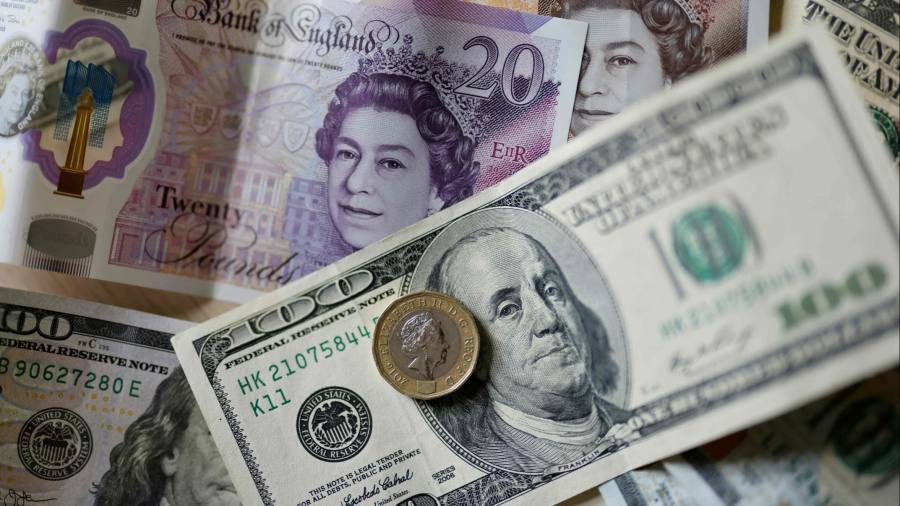Investment banks are turning more bullish on sterling as it trades close to a one-year high against the dollar and a five-month high against the euro, on expectations that the UK economy is performing better than many had feared.
The pound was trading at $1.2618 on Tuesday, close to the $1.2688 it hit on Monday, its highest level since April 2022. A euro bought £0.8698, sterling’s strongest level since mid-December.
Analysts believe that conditions are in place for the pound’s recovery to continue, after rising on a host of stronger than expected gross domestic product, manufacturing and jobs data this year, as well as a fall in the price of natural gas and broad weakness in the dollar.
“We are now taking an outright constructive stance,” said Goldman Sachs in a research note, expecting the pound to strengthen against other currencies including the euro.
“Essentially, we think that the same factors that acted as headwinds on sterling in 2022 — mostly natural gas prices and the relative stance of BoE policy — have turned to tailwinds,” it added.
Many traders, who had been betting against the pound around the start of the year amid forecasts of a deep recession, have been closing out their bets in recent weeks, which has also helped drive sterling higher.
Citigroup, which has been bearish on sterling for months, said in a note on Tuesday that it had been “wrong” and that “contrary to what we expected, activity [in the UK] has proven far more resilient”.
Sterling’s strength comes ahead of the Bank of England’s interest rate meeting on Thursday, where markets have priced in a near certainty of a 0.25 percentage point rate rise, in line with the Federal Reserve and the European Central Bank last week.
Themos Fiotakis, head of FX research at Barclays, said a brighter economic outlook in the UK combined with persistently sticky inflation meant “the BoE needs to be one of the more hawkish central banks”. Swaps markets are currently pricing in two and possibly three more rate rises by September.
“The UK economy is holding up a lot better than a lot of people had feared,” said Paul Robson, head of G10 FX Strategy at NatWest. “Most of the data surprises are to the upside and people having to revisit their excessive pessimism.”
Sterling is also trading at its highest level against the euro since December. Christian Kopf, head of fixed income at Union Investment, Germany’s third-largest asset manager, expects the euro to weaken further against sterling from its current level of £0.87 to £0.83 by the summer of 2024.
He said this was for a number of reasons including higher interest rates in the UK compared with Europe, the effect of Brexit on trade becoming less pronounced and the haven status of the euro and Swiss franc “dissipating”. This, he said, was encouraging more investors into “carry trades”, where returns are higher.
Kit Juckes, a currency strategist at Société Générale, said sterling had been buoyed by the fact that “the huge short position” traders had taken against the currency was being closed out.
Last month traders turned positive on the pound for the first time in 14 months, with more futures contracts betting it will rise for the first time since February 2022, according to data from the US Commodity Futures Trading Commission.
Nevertheless, there are still more traders betting on euro strength than on sterling. Juckes said this made sterling “an easy way of being short the dollar” because the euro is a “very crowded trade”.
NatWest expects sterling to strengthen to $1.30 by the end of the year. “We feel lending in the US will be more impaired than in the UK,” NatWest’s Robson said, adding that the fact the UK economy is more reliant on services than manufacturing compared with other countries should play in sterling’s favour.
Citi said it expected the euro to keep trading in the range of £0.87 to £0.89 in the near term ahead of the BoE rates decision, but said against the dollar, sterling “would continue to appreciate in our base case”.
A period of political calm and the signing of the “Windsor framework”, intended to smooth implementation of post-Brexit trading rules in Northern Ireland, has also played to sterling’s advantage in recent months.
“The truth is that, with the Rishi Sunak administration, a number of tail risks have been reduced, we’ve got the agreement on Northern Ireland, better co-operation with the EU and political stability, particularly compared with what happened last year,” said Athanasios Vamvakidis, head of G10 foreign exchange strategy at Bank of America.
Read the full article here



